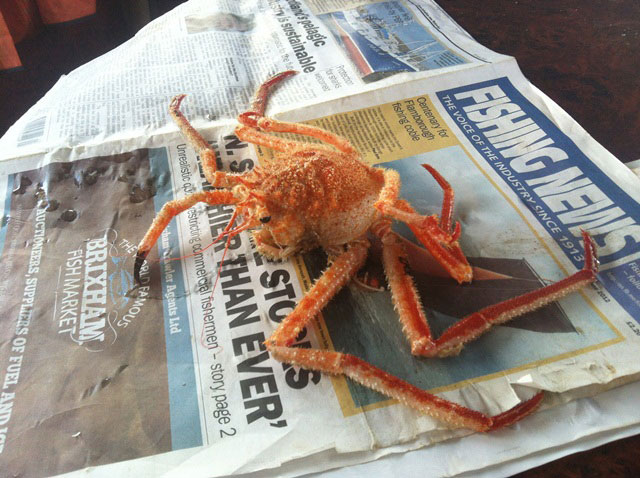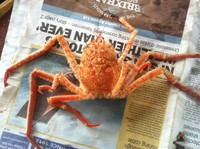Carrier Crab
Paromola cuvieri
Paromola cuvieri is found along the east coast of the Atlantic ocean from Angola in the south to the Northern Isles and Norway in the north. It is a deep-water species and normally found from 150 m to 345 m on the continental slope but can be found up to 1000 m. It was first recorded in Shetland waters in the mid-1950s.
The dorsal surface is covered with short spines and three longer spines are present in the rostral area. The chelae are long and slender, being twice the carapace length in males and somewhat shorter in females. A characteristic feature of the family Homolidae is the position of the 5th pair of walking legs which is situated sub-dorsally to enable them to carry objects on their backs. It is thought that this is for camouflage and protection against predators and objects observed include sponges, corals, and gorgonians.
Data sources
- Hayward, P.J.; Ryland, J.S. (Ed.) (1990). The marine fauna of the British Isles and North-West Europe: 1. Introduction and protozoans to arthropods. Clarendon Press: Oxford, UK. ISBN 0-19-857356-1. 627 pp.
- Gordon, I. (1956), “Paromola cuvieri (Risso) a crab new to the Orkneys, Shetland & Norway)”. Nature, 178, 1184-1185.
- Mary K. Wicksten (1985). "Carrying behavior in the family Homolidae (Decapoda: Brachyura)". Journal of Crustacean Biology 5 (3): 476–479
- http://eol.org/pages/1040173/entries/20656600/overview
Specimen details
While the carapace length can reach 160 mm, this specimen was 77 mm. The carapace width was 61 mm and one front claw had a span of 125 mm.

Carrier crab side view

Carrier crab top view
View the Discovery Zone Map.